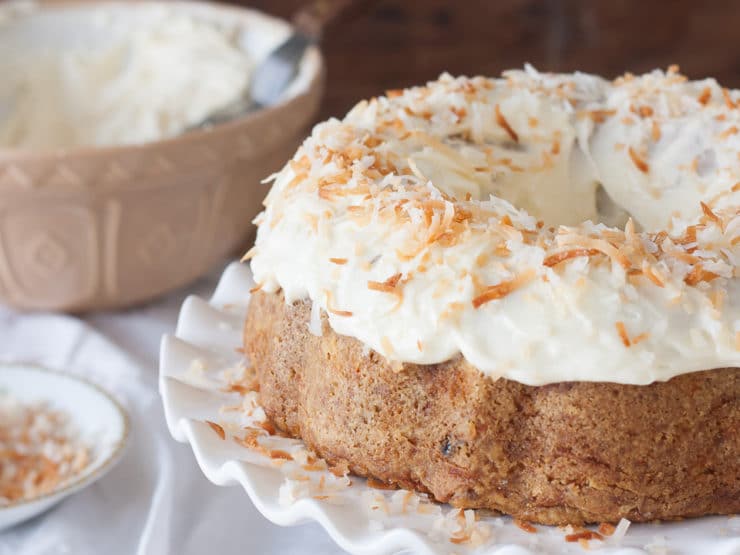
Editor’s Note: When originally published, the authorship of this piece was incorrectly labeled due to a web glitch. It was fixed after a few hours to reflect the correct author, Gil Marks. We apologize for the error.
“Vegetables are a must on a diet. I suggest carrot cake, zucchini bread, and pumpkin pie.”
-—Garfield Eats His Heart Out by Jim Davis (1983)
Carrot cake connotes a batter containing either grated raw or mashed cooked roots. Many versions are also commonly loaded with chopped nuts, raisins, and/or crushed pineapple. Those containing pineapple and coconut are sometimes called paradise cake, while carrot batters made with banana (and sometimes also some pineapple and coconut thrown in as well, which is actually a cross between a carrot cake and a hummingbird cake) yield a passion cake. References to ‘carrot cake’ before the late 19th century denoted various carrot puddings, soufflés, pies, or pancakes, but not anything remotely like a modern cake.
The original wild carrot, a native of southern Afghanistan, was quite different from its contemporary sweet elegant orange descendant. Feral carrots, called Queen Anne’s lace, provide a sense of what early carrots were like -— small, fibrous, woody, and not particularly tasty. The roots were used primarily as medicine and its seeds treated as a spice. Part of the reason for the carrot’s belated emergence as a food crop may have been certain physical similarities to a close relative, the poisonous hemlock.
The carrot was first recorded as cultivated for the root around 600 CE in Afghanistan and was purple in color. Traders traveling the Silk Road brought seeds of the carrot westward. Centuries later, horticulturists in western Asia bred out the anthocyanin pigment that gave early carrots their purple coloring. The result was pale yellow carrots. Yellowish carrots were considered preferable because they did not color soups and stews and hands. The carrot’s taste and texture also improved, although certainly not up to modern standards. Subsequently, the carrot and its close relative the parsnip were frequently confused with each other, although the parsnip was at the time more common and popular.
Arabs spread carrots to Iberia by the 10th century and the Spanish eventually brought them to their territories in Holland, where the improved root then spread eastward. By the 13th century, yellow carrots were being planted in France and Germany. Initially, carrots were a rarity and luxury item in much of Europe. However, they thrive even in poor soil and can be left in the ground or a root cellar through the winter. Therefore, around the early 15th century, after the flavor of the roots had improved over the centuries through selection and hybridization, cultivation grew widespread and carrots became a significant European food.
The now-common orange carrot, colored by high levels of carotene, emerged in Holland in the 16th century, noted in a 1564 painting by the Flemish artist Joachim Beuckelaer. This new color was particularly attractive to the Dutch ruling family, the House of Orange, at that time in a heated struggle for independence from Spain.
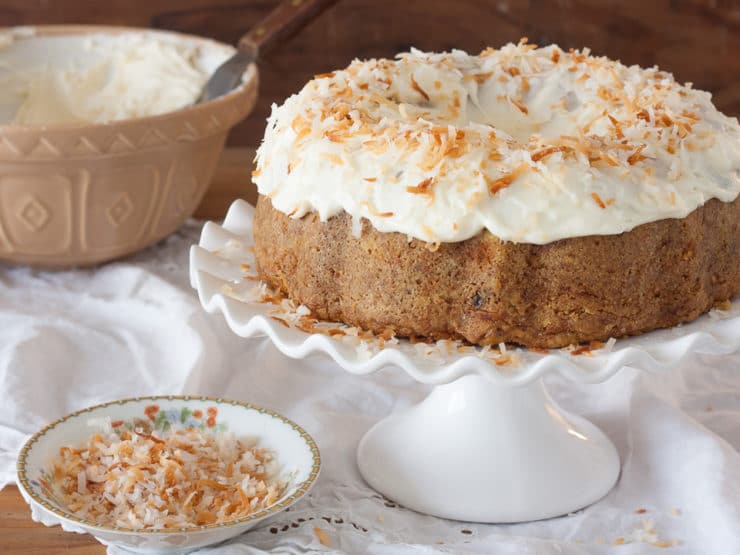
Note: When originally published, this blog post had authorship incorrectly labeled. Gil Marks is the author of the piece, as correctly noted above. We apologize for the glitch.
Carrots arrived in North America with the colonists at Jamestown and Plymouth. At first the roots, which were always eaten cooked, hardly made a dent on American cuisine. In the 17th through 19th century, the French developed new elongated and more succulent varieties that found commercial success in Western Europe and America. After the French bred improved varieties in the 1830s, the root suddenly found widespread commercial success in America and were increasingly consumed raw. The carrot now ranks second among vegetables only to beets in the amount of sugar it contains.
Meanwhile, with the increasing affordability in Europe of cane sugar from the Caribbean in the early 1600s (and later European sugar beets in the 1800s), cooks sweetened bread puddings and sometimes additionally enhanced them with raisins, ground almonds, and spices. Some substituted inexpensive and long-lasting root vegetables for the costly imported dried fruit and almonds, including parsnips, turnips, and, due to their inherent sweetness ultimately proving the most popular, carrots. An early English baked “Pudding of Carrot” was included in Acetaria: A Discourse of Sallets by John Evelyn (London, 1699): “Pare off some of the Crust of Manchet-Bread, and grate of half as much of the rest as there is of the Root, which must also be grated: Then take half a Pint of fresh Cream or New Milk, half a Pound of fresh Butter, six new laid Eggs (taking out three of the Whites) mash and mingle them well with the Cream and Butter: Then put in the grated Bread and Carrot, with near half a Pound of Sugar; and a little Salt; some grated Nutmeg and beaten Spice; and pour all into a convenient Dish or Pan, butter’d, to keep the Ingredients from sticking and burning; set it in a quick Oven for about an Hour, and so have you a Composition for any Root-Pudding.” A century later, the first American cookbook, American Cookery by Amelia Simmons (Hartford, 1796) contained a baked flourless custard-like “Carrot Pudding”: “A coffee cup full of boiled and strained carrots, 5 eggs, 2 ounces sugar and butter each, cinnamon and rosewater to your taste, baked in a deep dish without pastry.”
From the Venetian Ghetto came the Jewish torta di carote, a baked confection of carrots, ground almonds, sugar, olive oil, eggs, and raisins. The Art of French Cookery by Antoine Beauvilliers (London, 1827) included “Carrot Cakes. Gâteaux de Carottes” — actually a sweet carrot soufflé that would collapse as it cooled: “Take twelve large carrots, the reddest possible, boil them in water with a little salt; take out the hearts and drain them; put them through the cullender into a stewpan; dry them upon the fire, as pâte royale; make a cream pâtissière; put in as much flour as it will take; add the carrots, with a little confected orange-flowers minced, three quarters of a pound of sifted sugar, four eggs one after another, six yolks, and a quarter of a pound of melted butter; mix all well; whip the whites; mix them in lightly; prepare a stewpan as for the gâteau de riz, three quarters of an hour before serving put it into the oven.”
A genuine cake was the sturdier “Möhren-oder Wurzel-Torte” (Carrot or Root Cake) — a flourless and butterless almond egg-foam torte, the type still made for Passover and ideal for gluten-free folks — recorded in the German Praktisches Kochbuch (Practical Cookbook) by Henriette Davidis (Bielefeld, Germany, 1849, page 293), the most popular and influential German 19th century cookbook, initially issued in 1844 and continuously revised by Davidis and then others over the decades. This was the earliest version of a ‘carrot cake’ capable of remaining aloft when cooled. The recipe initially appeared in English in Practical Cook Book by Henriette Davidis (Milwaukee, 1897), an English translation “Compiled for the United States from the Thirty-fifth German Edition”: “Carrot Cake. 10 ounces of carrots, 14 eggs, 11 ounces of sifted sugar, 10 ounces of sweet and 2 ounces of bitter, grated, almonds, 2 heaping tablespoonfuls of sifted potato flour or cornstarch. Wash the carrots, cook them in water until about half done and then grate them; the heart is not used. Then stir the yolks of eggs with the sugar, the juice of a lemon and part of the grated rind of a lemon and the almonds, add the carrots, stir for half an hour as directed under No. 1, mix the beaten whites of 9 eggs with the potato flour and bake like almond cake for 1½ hours.” A similar flourless and butterless “Carrot Cake” was included in The Neighborhood Cook Book by the Portland Section of Council of Jewish Women (Portland, OR, 1912), many of the recipes of German origin.
Meanwhile in America, chemically-leavened “vegetable plum pudding” emerged containing grated carrots, grated potatoes, flour, raisins, suet, and baking soda. (These were based on English vegetable plum pudding, but those versions were absent the chemical leavening, a distinctive American innovation.) A Jewish form of baked pudding, called kugel or schalet, produced a more cake-like treat, such as the “Carrot Schalet” in The International Jewish Cook Book by Florence Kreisler Greenbaum (New York, 1918): “Boil one pound of carrots, let them get perfectly cold before grating them. In the meanwhile cream a heaping tablespoon of drippings or chicken fat and four tablespoons of sugar, add gradually the yolks of four eggs, the grated peel of one lemon, one teaspoon of cinnamon, a little grated nutmeg, three tablespoons of flour, one teaspoon of baking-powder, pinch of salt, and the beaten whites last. Heat a few tablespoons of fat in a pudding-dish, pour in the mixture and bake in a moderate oven one hour, then sprinkle sugar and cinnamon and return to oven for a few moments to brown. Serve hot.” Chemically-leavened carrot cakes followed containing more flour and using butter instead of suet or chicken fat.
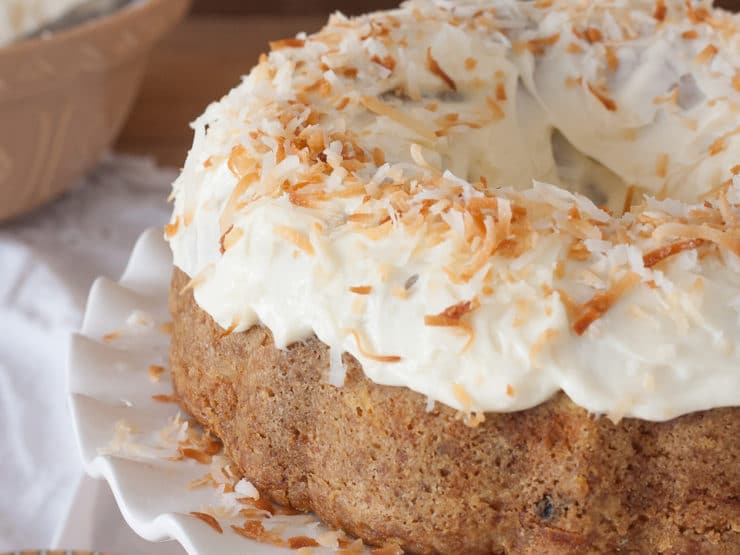
The earliest record of a carrot cake incorporating both wheat flour and chemical leavening was in The 20th Century Bride’s Cookbook by The Twentieth Century Club (Wichita, Kansas, 1929), a dense concoction consisting of cooked grated carrots mixed with flour, ground nuts, and baking soda (but no eggs) and baked in a loaf pan (it took many years for me to track down this actual book, but I did):
Carrot Cake
1 1/3 cups sugar
1 1/3 cups cold water
1 cup seeded raisins
2 tablespoons butter
2 grated carrots (of good size)
1 teaspoon cinnamon
1 teaspoon cloves
1 teaspoon nutmeg
Put all the ingredients in a sauce pan and boil very slowly for about five minutes. Remove from fire and allow mixture to become perfectly cold (never use while warm). Then add
1 cup walnut meats
2 cups flour
Pinch of salt
2 teaspoons baking soda
Bake very slowly in loaf tin for about one and a quarter hours. This makes a delicious fruit cake.
In the following year, the Chicago Daily News Cook Book edited by Edith Shuck (Chicago, 1930) provided the same recipe for “Carrot Cake,” albeit with a few more precise instructions – “Carrots (grated) 1½ cups” and “bake for 1¼ hours in oven 350 degrees.”
To be sure, none of the early carrot cakes attracted much enthusiasm outside of their communities. Despite a widespread misnomer, it did not gain popularity during World War II due to sugar rationing. Rather, influenced by the release of the details of the chiffon cake in 1948, American bakers began devising oil-based cakes in conjunction with eggs — a concept eventually applied to carrot cakes. The result was moister, denser, and more tender carrot cakes — that could be stored in the refrigerator without any deleterious effects. An early version was found in Favorite Recipes of New Jersey edited by Mary Anne Rogers (Montgomery, AL, 1965), compiled from “women’s club leaders in New Jersey” by the staff home economist of Favorite Recipes Press: “Carrot Cake. 4 eggs 2 с sugar 1½ с vegetable oil 2 с grated carrots 3 с flour 2 t. baking soda ½ t. salt 2 t. cinnamon 1½ с nuts ½ с raisins, (opt.) Beat eggs, sugar and oil; add carrots and sifted dry ingredients alternately to egg mixture. Beat until well mixed. Add nuts and raisins. Bake in large ungreased tube pan for 1 hour and 15 minutes at 325 degrees. Yield: 12-16 servings.” Although some people insist the butter cake version tastes better, it was the succulent oil-based carrot cake that initially sparked and still maintains this dessert’s incredible popularity.
In addition, one particular development in the 1960s was responsible for transforming carrot cake from an obscure dessert into a beloved American classic – pairing it with cream cheese frosting. This form of topping initially appeared in the early 1930s. The American Home magazine (New York, 1933) promoted cream cheese frosting to spread on “cake made with tomato soup.” (For some reason, this cake variation failed to thrive, although the frosting certainly did.) Cream cheese frosting gained national attention in 1948 when it was used in the famous “Brown Derby Grapefruit Cake,” a variation of chiffon cake. Perhaps the first printed record of its memorable coupling with carrot cake was in the September 10, 1964 edition of The Washington Post and Times-Herald (the name was only officially shortened to Washington Post in 1973) in the Reader Exchange (p. D4): “Another reader recommends a cream cheese frosting for carrot cakes: ‘Use 4 ounces cream cheese and mix with ¼ stick margarine. Add 1 teaspoon vanilla and half a box of confectioners’ sugar. Mix into smooth frosting.’” The Better Homes and Gardens New Cook Book (Des Moines, IA, 1968) provided a recipe for “Carrot-Pineapple Cake” replete with an oil-based cake with “crushed pineapple (with syrup)” and a cream cheese frosting. Pointedly, earlier editions of The Better Homes and Gardens books did not include any carrot cake recipes. Subsequently in the 1970s, carrot cake with cream cheese frosting emerged as a standard in American restaurants, bakeries, magazines, and cookbooks. Frozen versions appeared in the freezer cases of supermarkets. Unlike many food fads of that era, carrot cake with cream cheese frosting endures. February 3rd was declared National Carrot Cake Day.
Carrot cake is certainly one of my favorite treats, enlivened by speckles of the vegetable scattered throughout as well as hints of spice. It is also extremely easy to put together, akin to a quickbread, without the prolonged beating of eggs or butter; it does not require an electric mixer. Since carrots contain some acid, baking soda serves as a leavening. In addition, when carrots are exposed to alkali (baking soda) and heat, the cellulose in the cell walls disintegrates allowing the water to seep out. Thus if only baking powder were used for the leavening, the carrots remain too crisp and the cake dry. Some whole wheat flour absorbs excess moisture. Macerating the carrots in sugar extracts additional moisture and sweetness from them, resulting in a more intensely-flavored and darker-colored cake.
Plain carrot cake makes an excellent coffeecake. Stacked and topped with frosting, it transforms into a layer cake fit for the fanciest of occasions, including birthdays, Mother’s Day, Valentine’s Day, Easter, Halloween, Thanksgiving, and even weddings. When you really want to show off, top each slice with a marzipan carrot. And you can even rationalize that vegetables make it a health food.
Recommended Products:
We are a participant in the Amazon Services LLC Associates Program, an affiliate advertising program designed to provide a means for us to earn fees by linking to Amazon.com and affiliated sites. As an Amazon Associate I earn from qualifying purchases.
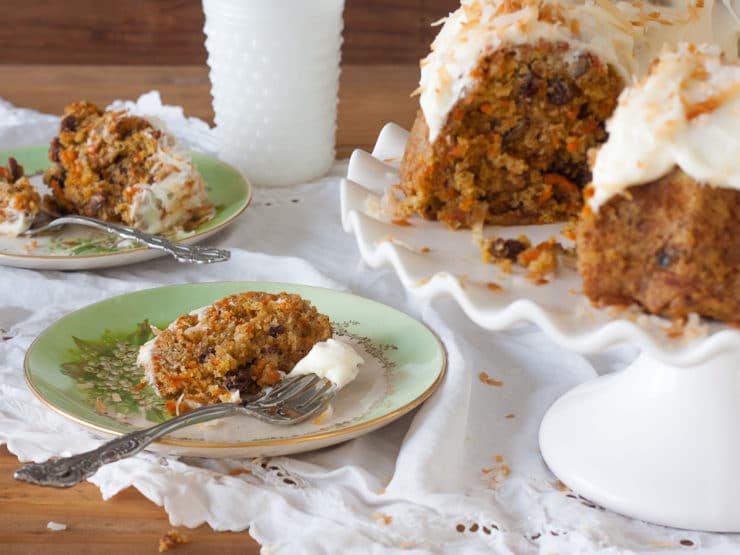
Food Photography and Styling by Louise Mellor
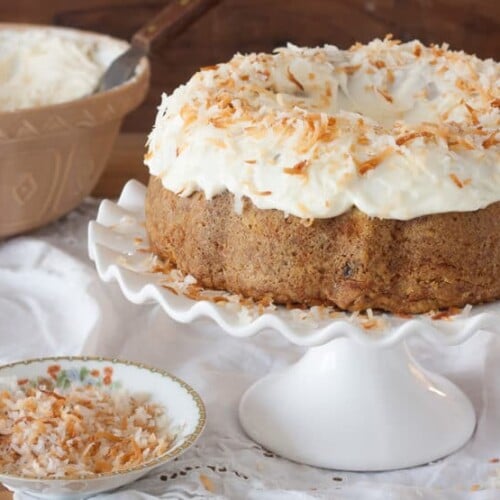
Carrot Cake
Ingredients
Cake Ingredients
- 2 1/4 cups all-purpose flour, preferably unbleached, or 1½ cups all-purpose flour and ¾ cup whole wheat flour (9.5 ounces/275 grams)
- 2 cups granulated sugar, or 1½ cups granulated sugar and ½ cup packed light brown sugar (14 ounces/400 grams)
- 2 teaspoons ground cinnamon
- 3/4 teaspoon ground ginger, allspice, nutmeg, or cloves, or ¼ teaspoon ground ginger and ¼ teaspoon ground nutmeg
- 2 teaspoons double-acting baking powder
- 1 teaspoon baking soda
- 1 teaspoon salt
- 1 1/2 cups vegetable or peanut oil (11.25 ounces/325 grams)
- 4 large eggs, lightly beaten (¾ cup/7 ounces/200 grams)
- 2 teaspoons vanilla extract
- 3 1/2 cups lightly packed finely grated carrots (6 to 8 medium/14 ounces/400 grams)
Cake Additions (Optional)
- 1 cup raisins, chopped pitted dates, or blueberries (5 ounces/140 grams)
- 1 cup shredded coconut (3 ounces/85 grams)
- 1 cup toasted and coarsely chopped pecans or walnuts (4 ounces/115 grams)
- 1 cup canned crushed pineapple, drained (8 ounces/225 grams)
Cream Cheese Frosting Ingredients
- 2 cups cream cheese, softened (16 ounces/455 grams)
- 10 tablespoons unsalted butter, softened (1¼ sticks/6 ounces/170 grams)
- 1 tablespoon pure vanilla extract
- 2 tablespoons fresh lemon juice, 2½ tablespoons sour cream, or 1 tablespoon orange liqueur (optional)
- Pinch salt
- 3 cups confectioners’ sugar, sifted (12 ounces/340 grams)
- Marzipan carrots or about 1 cup toasted coconut for garnish (optional)
NOTES
Variations
Carrot Cupcakes: Divide the batter between 24 (2½-inch) cupcake tins, filling no more than three-quarters full, and bake at 350°F (325°F for a convection oven), rotating the pans halfway through, for about 18 minutes. Lower-Fat Carrot Cake: Substitute 1 cup (8.75 ounces/245 grams) unsweetened applesauce and ½ cup buttermilk for the oil and 6 large (¾ cup) egg whites for the whole eggs, and reduce the sugar to 1½ cups (10.5 ounces/300 grams). Passion Cake (Carrot-Banana Cake): Reduce the oil to ¼ cup (2 ounces/60 grams), baking powder to 1 teaspoon, and eggs to 3 (5.25 ounces/150 grams) and add ¾ cup (1½ medium/6 ounces/170 grams peeled) mashed bananas. Beet Cake: Reduce the carrots to 1 cup and add 1 cup finely shredded beets. Chocolate Carrot Cake: Omit the cinnamon and ginger and sift ½ cup (1.5 ounces/40 grams) unsweetened cocoa powder with the flour. Honey Carrot Cake: Reduce the sugar to 1½ cups (10.5 ounces/300 grams) and add ½ cup honey (5.875 ounces/170 grams). Zucchini Cake: This vegetable cake became popular in the 1970s as America experienced another period of health food faddism, yet remained reluctant to completely eschew sweets. Another reason for its surge in popularity was the increase in home gardening and the surplus of squash. Substitute 3 cups (2 medium/12 ounces/340 grams) shredded unpeeled zucchini for the carrots and ¼ teaspoon ground cloves for the ginger.Instructions
To Make Cake
- Position a rack one-third up from the bottom of the oven. Preheat the oven to 350°F (325°F for a convection oven). Grease and lightly flour two 9- by 1½-inch round pans, three 8- or 9- by 1½-inch round pans, two 8-by 4-inch loaf pans, one 13- by 9- by 2-inch baking pan, or one 10-inch (12-cup) Bundt or tube pan.Sift together the flour, spices, baking powder, baking soda, and salt. In a large bowl, beat together the eggs and sugar. Beat in the oil and vanilla. Stir in the flour mixture.

- Add the carrots and, if using, 1 to 2 cups any combination of additions. It will be a rather loose batter.

- Pour into the prepared pans. Bake until a tester inserted in the center comes out nearly clean and the cake springs back when lightly touched, 30 to 40 minutes for 9-inch pans; 20 to 30 minutes for 8-inch pans; 45 to 55 minutes for a 13- by 9-inch pan; or about 1 hour for a Bundt pan or loaf pan.Let cool in the pans for 15 minutes, then remove the cake to a wire rack and let cool completely, at least 1½ hours. Wrap in plastic wrap and store at room temperature for up to 3 days, in the refrigerator for up to 1 week, or the freezer for up to 3 months.

To Make Frosting
- In a medium bowl, beat the cream cheese and butter until smooth, about 1 minute. Blend in the vanilla and, if using, lemon juice.

- Gradually add the sugar and beat until smooth and of a spreading consistency, about 4 minutes.

- Spread the top and sides with the frosting. If desired, garnish with marzipan carrots or toasted coconut. Refrigerate for at least 1 hour.

Nutrition

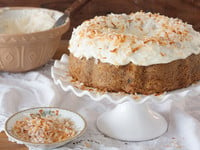
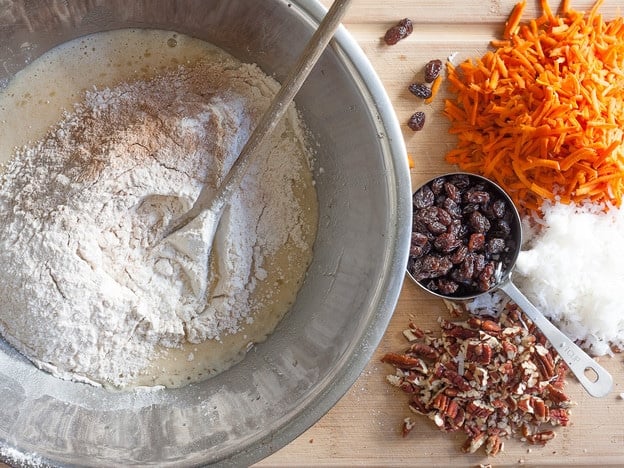
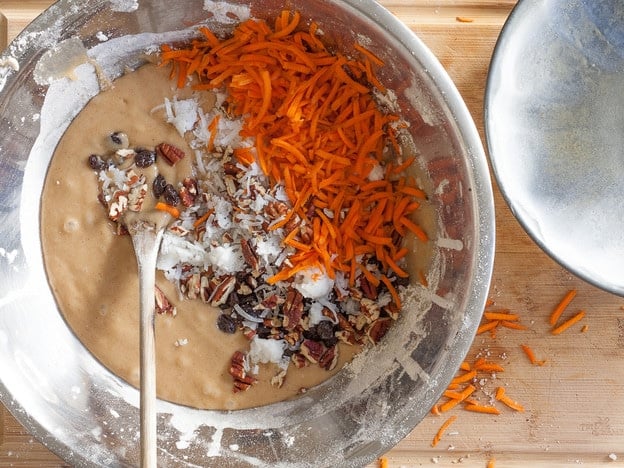
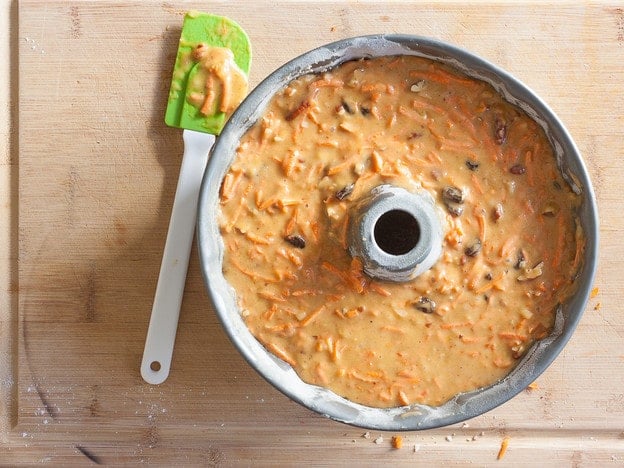
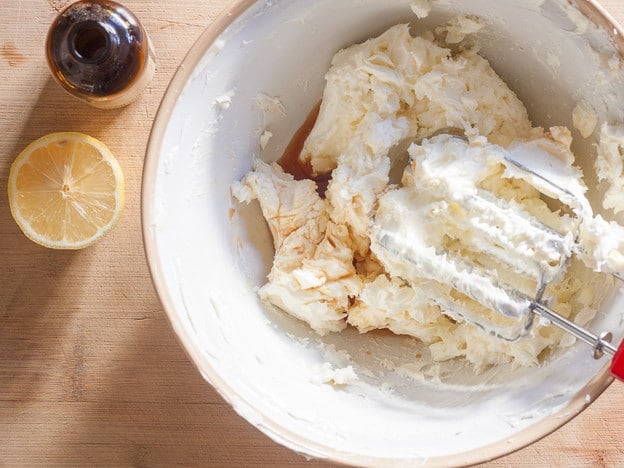
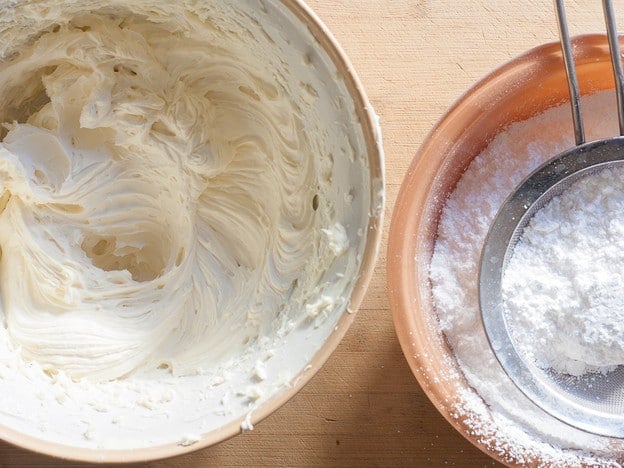
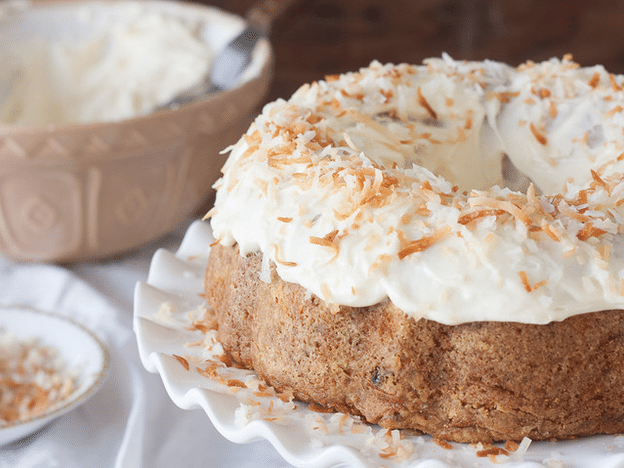


Make the cake – two nine inch layers. Delicious!!! Tried to make the cupcakes following the directions – had to throw them out. They would not cook even with adding time and rotating pans. What a lot of work for nothing. I will stick with the cake.
I love this carrot cake. Totally delicious, and nice and interesting to make. Thanks for the share!
All your fans should be shipped a slice of this! 😀 Just a suggestion!
I’m making it right now.
I absolutely love carrot cake and that looks super delicious
Love your Honey Cake recipe! Happy Hanukkah Tori!
I grew up eating delicious steamed carrot pudding for Christmas. The recipe was in my family from the 19th century. It was served with what my grandmother called “hard sauce,” which is funny because the sauce contained no alcohol. It was made of butter and sugar and egg. Midwestern Methodist-style “hard sauce,” I guess. Anyway, it was all DELICIOUS and makes me think that I must make it.
Why does no one inform me of these delicious holidays???
I love cake. And, I love pie!
its yummy …can i use only whole wheat flour …i mean in place of all purpose flour
You Americans sure like sugar
Look delicious Tori <3
My fav cake!! Yum
My son Brian makes an awesome wicked Carrot cake
Awesome job!
YUM!
mmm frosting!!
traditions of yum, one of my favorite things!
Yum
that looks so delicious
Diane cream cheese frosting is my weakness!
believe me, IT IS!